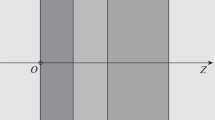Abstract
FollowingDmitriev (1960) a rigorous theoretical solution for the problem of scattering by a perfectly conducting inclined half-plane buried in a uniform conductive half-space has been obtained for plane wave excitation. The resultant integral equation for the Laplace transform of scattering current in the half-plane is solved numerically by the method of successive approximation. The scattered fields at the surface of the half-space are found by integrating the half-space Green's function over the transform of the scattering current.
The effects of depth of burial and inclination, of the half-plane on the scattered fields are studied in detail. An increase in the depth of burial leads to attenuation of the fields. Inclination introduces asymmetry in the field profiles beside affecting its magnitude. Depth of exploration is greater for quadrature component. An interpretation scheme based on a phasor diagram is presented for the VLF-EM method of exploration for rich vein deposits in a conductive terrain.
Similar content being viewed by others
Abbreviations
- x, y, z :
-
Space co-ordinates
- σ:
-
Half-space conductivity
- μ0 :
-
Free-space permeability
- ω:
-
Excitation frequency (angular)
- T :
-
Time
- h :
-
Depth of the half-plane
- a :
-
Inclination of the half-plane
- E x :
-
x-Directed total electric field
- E px :
-
x-Directed primary electric field
- E pxo :
-
x-Directed primary electric field atz=0 directly over the half-plane
- H y :
-
y-Component of total magnetic field
- H py :
-
y-Component of primary magnetic field
- H py0 :
-
y-Component of primary magnetic field atz=0 directly over the half-plane
- H z :
-
z-Component of total magnetic field
- H pz :
-
z-Component of primary magnetic field
- J x :
-
Surface density ofx-directed scattering current
- G :
-
Green's function
- k 0,K :
-
Wave numbers
- u,u 0,u 1,u 2 :
-
Functions
- ζ:
-
Space co-ordinate
- s :
-
Variable in transform domain
- γ:
-
Variable of integration
- ϕ:
-
Normalized scattering current
- Ф:
-
Laplace transform of ϕ
- N :
-
Normalized Ф
- η, η0, η1, η2 :
-
Functions
- t :
-
Variable of integration
- δ:
-
Skin depth
- H :
-
Total magnetic field
- H p :
-
Primary magnetic field
- H p0 :
-
Primary magnetic field atz=0 directly over the half-plane
- M,Q,R,S,U,V :
-
Functions
- N 1,N 2 :
-
Functions
References
Anderson, W. L. (1975),Improved Digital Filters for Evaluating Fourier and Hankel Transform Integrals, NTIS Doc. No. PB-242 800, U.S. Dept. Commerce.
Bladel, J. V.,Electromagnetic Fields (McGraw Hill, Inc., New York, 1964).
Dey, A., andMorrison, H. F. (1973),Electromagnetie Response of Two-dimensional Inhomogeneities in a Dissipative Half-space for Turam Interpretation, Geophysical Prospecting21, 340–365.
Dmitriev, V. I. (1960),A Solution for a Basic Problem in the Theory of Induction Method of Electromagnetic Surveying. Bull. Acad. Sci. USSR, Geophys. Ser., No. 8, 748–753.
Dmitriev, V. I. (1961),The Screening of an Anomalous Field by Sediment. Bull. Acad. Sci. USSR, Geophys. Ser., No. 1, 27–30.
Dmitriev, V. I., andZakharov, E. V. (1966),Diffraction of Plane Electromagnetic Field by Ideally Conducting Half-plane Buried, in a Homogeneous Half-space. Numerical Methods and Programming 5 (Moscow Univ., in Russian).
Hohmann, G. W. (1971),Electromagnetic Scattering by Conductors in the Earth Near a Line Source of Current, Geophysics36, 101–121.
Kaikkonen, P. (1979),Numerical VLF Modeling. Geophysical Prospecting27, 815–834.
Lajoie, J. J., andWest, G. F., 1976,The Electromagnetic Response of a Conductive Inhomogeneity in a Layered Earth. Geophysics41, 1133–1156.
Olsson, O. (1980),VLF Anomalies from a Perfectly Conducting Half-plane Below an Overburden. Geophysical Prospecting28, 415–434.
Paterson, N. R., andRonka, V. (1971),Five Years of Surveying with the Very Low Frequency Electromagnetic method. Geoexploration,9, 7–26.
Peltoniemi, M. (1981),Comments on ‘Numerical VLF Modeling’ and ‘VLF Anomalies from a Perfectly Conducting Half-plane Below an Overburden’ Geophysical Prospecting29, 298–302.
Vozoff, K. (1971),The Effect of Overburden on Vertical Component Anomalies in AFMAG and VLF Exploration: a Computer Model Study. Geophysics36, 53–57.
Wait, J. R. (1959),On the Electromagnetic Response of an Imperfectly Conducting Thin Dyke. Geophysics24, 167–171.
Ward, S. H., Ryu, J., Glenn, W. E., Hohmann, G. W., Dey, A., andSmith, B. D. (1974),Electromagnetic Methods in Conductive Terranes. Geoexploration12, 121–183.
Wesley, J. P. (1958a),Response of Dyke to Oscillating Dipole. Geophysics23, 128–133.
Wesley, J. P. (1958b),Response of Thin Dyke to Oscillating Dipole. Geophysics23, 134–143.
West, G. F. (1960),Quantitative Interpretation of, Electromagnetic Prospecting Measurements. Ph.D. thesis, Univ. Toronto, Toronto.
Zakharov, E. V., andDmitriev, V. I. (1966),Electromagnetic Wave Diffraction by an Ideally Conducting Half-plane in a Layered Medium. Izv. Acad. Sci. USSR, Phys. Solid Earth, No. 11, 713–721.
Author information
Authors and Affiliations
Rights and permissions
About this article
Cite this article
Poddar, M. Electromagnetic scattering by a perfectly conducting half-plane in a conductive half-space. PAGEOPH 119, 1024–1036 (1981). https://doi.org/10.1007/BF00878967
Received:
Revised:
Issue Date:
DOI: https://doi.org/10.1007/BF00878967




